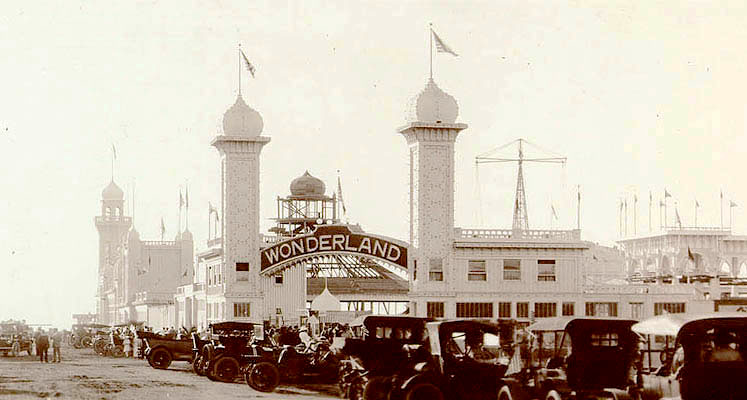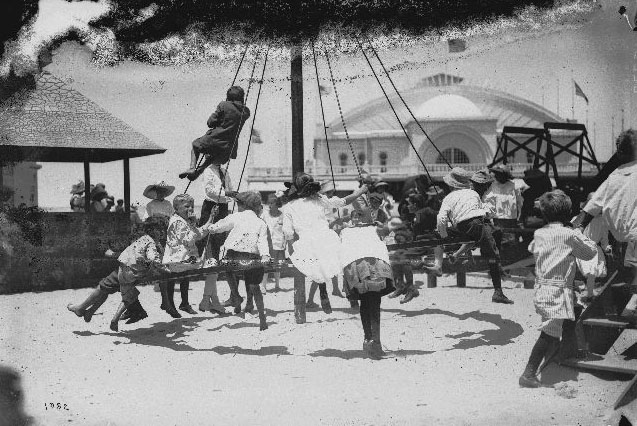

WONDERLAND PARK – OCEAN BEACH, CA
(1913-1914)
Written by Jeffrey Stanton
The San Diego area’s first amusement park opened in the small beach town of Ocean Beach on July 4, 1913. Ocean Beach, which is located across the San Diego Bay from downtown San Diego, was first, proposed by developers Bill Carlson and Frank Higgins in 1887. They developed the Cliff House, a resort hotel, and subdivided the area into lots. Despite their efforts with elaborate promotions, the development did not do well, because it was an eight mile drive, 2-1/2 hours by carriage from downtown San Diego. They launched the Ocean Beach Railroad in April 1888 where passengers could take a ferry from San Diego to Roseville in Point Loma, then ride the train to the Cliff House. However, Ocean Beach was a causality of an economic downturn that year. When Cliff House burned down in 1898, Higgins committed suicide. Carlson sold the development to an eastern financier, but its development would await trolley service for nearly two decades.
Wonderland Park was built in 1913 on an arid sandy beach south of Abbot Street, between Volatire Street and the ocean by Ocean Bay Beach Amusement Company owned by Herbert P. Snow (manager was Bert Snow) for $400,000. Money was divided between erecting buildings, all with concrete floors, ride construction, and driving over 1200 feet of bulkhead and 900 piles for the boardwalk and a short pier. The carefully planned amusement park covered an area of 9-1/2 acres. Many wondered how San Diego’s population of 65,000 could support such a venture, but amusement parks were built throughout the country in small towns and cities with similar populations.
The public sneak preview of Wonderland, two days before its scheduled July 4 opening, delighted thousands of visitors. When Mayor Charles F. O'Neall threw the switch precisely at 7 P.M., 22,000 tungsten lights outlined the buildings of the new amusement park at Ocean Beach. The entrance gates, framed by towering minarets ,opened and the waiting throngs poured in, accompanied by a band playing “America.” Admission to the park’s grounds was ten cents – rides and attractions were extra. San Diegans had never seen anything like it.
More than 20,000 people came on opening day. The Point Loma Railroad Co. ran streetcars every 20 minutes from Fourth and Broadway for the 40-minute trip to Ocean Beach. Buses from Horton Plaza ferried people to the park, one vehicle every 30 minutes.

Wonderland Park's Entrance - 1913
Wonderland Park’s 32 attractions were all operated by the park itself. [This was rather unusual for a park, since many small parks erected the major rides and buildings then advertised for small ride owners and game concessionaires to place attractions in their park.]. Its ride attractions included the Ingersoll constructed Blue Streak racing coaster where two trains raced each other on parallel tracks over its 3500 foot length, a Chute-the Chutes, a high, steep water-slide where flat-bottomed boats shoved off from the top, to whoosh down into the pool below while spraying water over the shrieking passengers, and a Trip thru Panama, a scenic boat ride. Other attractions included the riggler, Girl From Up There (show), crater, a Hershell-Spillman carousel, joyland, bump-the-bumps, Blarney Castle, a hot salt-water bathing plunge, bowling alley, roller skating rink, half-acre children’s playground, band shell, theater, Japanese tea garden, and game booths. Its Casino, a restaurant built over the ocean on the pier, could serve 550 patrons at one time.

Blue Streak Racing Coaster & Shoot the Chutes
Its zoological gardens had 28 cages for different animal species, which included lions, bears, leopards, wolves, mountain lions, a hyena and 56 varieties of monkeys. Monkeyland with its100 monkeys making funny faces and reaching for peanuts and popcorn from visitors charmed the children. One was the mischievous Mr. Spider, advertised as 'the oldest monkey in captivity,' who often reached out through the bars with his tail and whisked an unwary visitors’ hat off.

Pool and BlueStreak Coaster
The Waldorf Ballroom’s dance floor was 125 x 150 feet. Unseemly behavior in on the dance floor required particular vigilance. To ensure that there was no “turkey trotting” or “bunny hugging” on the dance floor in the Waldorf Ballroom, Mrs. Margaret Madden kept a watchful eye.
For the official July 4th opening, the park added fireworks, with music from the Royal Marine Band. “The Battle in the Clouds” ran all day and into the evening, directed by Signore Paglia, the “famous master of pyrotechnics” and former director of displays for the king of Italy. Reflecting the conservative mores of the day, the family-oriented Wonderland was advertised as “morally clean,” safe and wholesome. Violators of respectability risked expulsion.

Children's Playground
Park attendance that first season was strong and the park was on its way to profitability. The owners announced that the second season would begin on January 1st, since San Diego’s weather was conducive to year-round operation on weekends. But, Wonderland thrived for only two seasons. For all their careful planning, the operators of the park failed to consider the prospect of competition. The opening of the Panama-California Exposition in 1915 at Balboa Park slashed attendance, and the park fell into foreclosure. In March 1915, Wonderland was sold at auction.
To add insult to injury, stormy ocean tides undermined the foundations of the giant roller coaster and closed the park's premier attraction in January 1916. The Blue Streak Racer was dismantled and shipped to Santa Monica Pier , where it ran at the Pleasure Pier until 1924. Much of the rest of the park was washed away by winter storms and high tides.
The most enduring legacy of Wonderland would be its small zoo. When the Panama-California fair began in Balboa Park, the menagerie was rented to the exposition company for $40 a day. Housed in a series of cages near Indian Village on Park Boulevard, the collection of animals was eventually sold to the city for $500. The well-traveled animals would appear again when the San Diego Zoo opened in 1922.
Later in the 1910s, Ocean Beach became one of the many San Diego neighborhoods connected by streetcar and an extensive San Diego public transit system that was spurred by the Panama-California Exposition of 1915 and built by John Sprekels. These streetcars became a fixture of this neighborhood until their retirement in 1939.
Wonderland Park reopened on June 5, 1921. While the old park had been demolished seven years earlier, a new café and salt-water plunge opened. The large crowd, which attended a gala affair hosted by the American Legion on Memorial Day, hoped that additional attractions would soon be added.